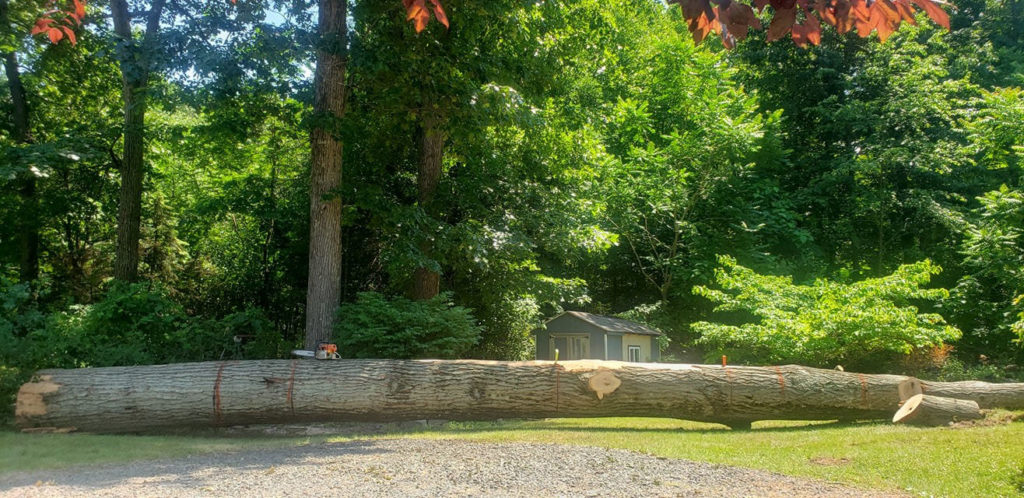Handling small tree removal is not a complex process but without following a set of guidelines, this could potentially be a safety issue. Evergreen Tree trimming and removal service in Pleasanton can help with your tree problems. we recommend following the guideline in the book called “HomeOwner’s Complete guide to the Chainsaw” – by “Brain J Ruth” and “Jen W. Ruth”.
There is nothing simple about felling most trees. Perhaps I would consider a small tree, with a slight lean, in the middle of a field, on d windless play, simple. Anything else can be anything but simple.
Due to the surprising weight of a tree and the power it possesses, the forces it can exert are tremendous. A careless mistake or miscalculation could destroy property, or earn you a trip to the hospital or worse. If you are not confident in your ability to handle the saw or properly assess the situation and do the job safely, you should leave it to a professional.
One of the worst scenarios is to leave a half-fallen tree—one that gets hung up in a tree or trees around it. It is like a stick of dynamite where the fuse burns right up to the stick: too dangerous to approach and too dangerous to leave alone. If this happens, do not try to be a hero. Clear the area of bystanders until a professional tree service can remedy the situation.
Once the tree is down, it must then be limbed and cut up, or bucked, Which require a completely different set of skills. Finally, you must plan any tree fall safely and, as my father always told me, “Keep your mind on what you are doing!”
 Felling Plan
Felling Plan Before you tackle the tree, it’s important to make a felling plan. This simply means looking and thinking methodically to figure out:
■ where the tree would most naturally fall,
■ where you would prefer it to fall,
■ what you can do to direct its fall,
■ where you will go while it falls,
■ what clearing and other preparations you need to do first.
 DIRECTION OF FALL
DIRECTION OF FALL It is usually easy to decide the direction you would like a tree to fall, but getting it there can be a different story. You have to assess the risk of having the tree fall the wrong way and what damage it could cause. If there are buildings, power lines, or other trees around, perhaps you should have a professional take down the tree.
A large tree can literally cut a house in half. The following things will influence the direction of fall:
■ Natural Lean. It can be difficult to fell a tree in a desired direction if it is leaning in the opposite direction.
■ Weight Distribution. If the tree’s crown (branches and upper weight) puts more weight on one side of a tree than the other, the tree will tend to fall in the direction of its heaviest side. Snow and ice can also influence weight distribution.
■ Entanglement. A tree that is naturally entwined with another tree or connected to another tree by way of a climbing vine can be difficult to fell, and it is almost impossible to assess which direction it will fall.
■ Defects. If the tree is anything but solid and healthy, safe felling could be difficult. Rot, punky wood, or a hollow trunk may not be visible from the outside of the tree. Look for external scars, deadwood in the crown, or ants and other insects. Tap the trunk with your ax and listen for a hollow sound. This is almost a sure sign of extensive heart rot and the tree should be avoided or left to a professional to fell.
■ Wind. The force wind can exert on a tree may greatly affect its fall direction. Take a look at the strength and direction the wind is blowing. If you are trying to fell the tree against the prevailing wind, you likely will lose.
To tell which way a tree is leaning, hold your ax between your thumb and forefinger at the end of the handle as gently as you can. Now with the ax head down, use the ax as a plumb bob. You’ll be able to see which way the tree is leaning. The tree in the photo above, though growing on a slope, is straight up and down.
 ESCAPE ROUTE
ESCAPE ROUTE Before felling any tree, it is a good idea to think through your escape route. Most felling accidents happen within twelve feet of the tree stump. If a tree snapped off its hinges during a fall, it usually kicks back over the stump. Also, if the tree you are felling is on a hill, it is more to kickback over the stump as well as or roll down the hill until it comes to rest. In addition, as the trunk falls, it is likely to ounce off its branches, and this could send in any direction—including back toward the stump or to either side of the stump.
So, the first question is, what is the normal direction you would move out of the may as the tree falls? And then, what if the tree does not fall in the normal direction? The best plan is to clear an escape route diagonally away from the direction of the fall.
This usually means some cleaning out of brush from around the tree so you have good footing and to prevent your saw from inadvertently hitting a branch or stick. Also, clear out any deadwood, live trees, or saplings from the direction of fall to prevent them from being thrown back during the fall.
If the tree you are cutting has branches below shoulder height, cut and remove these from the working area and escape route as well. And look up in the tree for window makers—dead branches that may become dislodged and fall on you. Remove them if you can; be very wary of them if you cannot. Finally, clear out bystanders. I always recommend a safe distance of at least two times the height of the tree for people and property.
 Felling a Small Tree Steps:
Felling a Small Tree Steps:1. Making the horizontal scarf cut. This tree leans slightly toward the desired direction of fell. There’s no wind, so good felling cuts should do the trick. The first (or lower) cut of the scarf should be level and horizontal. Jen stands on the side of the tree so the direction of fall will be directly to her right.
With her knees slightly bent, holds the saw about waist high, with the left side of the front handle in her left hand. (Your left hand will not be behind the handguard/ chain brake; therefore, it is important to have cleared any brush from around the tree to help Avoid kickback.) With the engine housing resting against the tree, she brings the engine to full throttle and drives the guide bar into the tree, swinging in a horizontal arc. She cuts between one-quarter and one-third of the way through the diameter of the tree. Then, she will reduce the engine to half throttle, remove the saw bar from the cut, and the throttle down completely.
2. Making the angled scarf cut. The second (or top) cut is a little more difficult. It should start above your first cut and angle down to meet your first cut. The goal is to precisely meet your first cut at its deepest point. For softwoods, the angle of cut should be forty-five degrees. For hardwoods, it should be thirty degrees. Loggers differ on the most sensible order of cuts when making the notch. Many believe it is easier to line up the two cuts cleanly if you make the upper sloping cut first, then make the horizontal cut to meet it.
3. Keep guide bar square. When making the second cut, Jen pushes the guide bar squarely along its diagonal path, not in an arc as she did before. I like to stop about one-third of the Way through, remove the saw, and check my progress from both sides of the tree. If the kerf is not aligning with the first cut, I readjust my saw angle and start cutting again.
4. Remove the wedge of wood. A chunk of wood that resembles a triangular slice of watermelon will be removed when both cuts meet one-third to one-quarter of the way into the tree.
5. The felling cut. Next, make a felling cut horizontal and level like the first scarf cut but on the opposite side of the tree and one to two inches higher than the horizontal (bottom) scarf cut. This cut is also called the back cut because it is made opposite the direction of fall. Jen holds the saw with her left hand on the side of the front handle. She bends her knees slightly and positions her feet for good stability. Before culling, look back over your shoulder to the right your escape route,
6. Hinge wood. Throttle up arid make the cut, but stop before you reach the scarf cut. This allows for a strip of wood to act as a hinge. Because Jen is felling the tree in the direction of its natural lean, the hinge wood should be uniformly wide from one side of the tree to the other, and its width should be one-tenth of the diameter of the tree (a ten-inch diameter tree should have a one-inch hinge and a twenty-inch diameter tree should have a two-inch hinge).
7. Pullers can start pulling. As the back cut nears ten percent of hinge wood, your rope pullers (if you are using them) should start pulling. Or the tree may start to pivot on the hinge on its own and start to fall. Or the tree may lean back the wrong way on its hinge. You need those rope pullers, and you may need to drive wedges into the saw cut to redirect it.
8. Remove. Observe. Escape. As soon as the tree starts to fall, Jen removes her saw and observes the direction it is falling. If it’s falling correctly and you have a clear path toward your escape route, as Jen does, shut off your saw, set it down (or, as shown here, engage your chain brake and take it with you), and retreat along your escape route.

